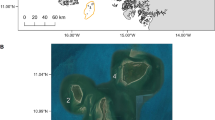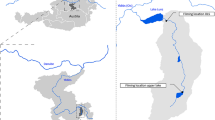Abstract
Atlantic salmon, Salmo salar, deposit their eggs in excavated depressions called nests. These nests are built from downstream to upstream within one or more redds, and each redd corresponds to a continuous area of the streambed disturbed by the female digging activities. Redd topographic measurements and egg excavation were performed to determine number of nests per redd and per female, nest depth, distances between successive nests, number of eggs deposited per nest, and egg survival in nests created by six grilse Atlantic salmon, five spawning in an experimental stream (Lapitxuri channel) and one in a natural stream (Lurgorrieta Creek, a tributary of the Nivelle River in southwest France). All females constructed a single redd, except one which built two redds in the channel. Redd surface area ranged between 2.3 and 5.7 m2. Each redd had a raised mound of gravel or dome under which most of the eggs were located, and an upstream depression or ‘pot’. Based on expected egg-to-juvenile survival rates previously obtained in the Lapitxuri channel and on juvenile recoveries, between 96 and 97% of the eggs deposited in the channel sections were retrieved. Each female constructed 7 to 11 nests over a period of 3 to 5 days. The first three nests had an average burial depth of 12.9 cm (±1.6 SD) which was greater than the last three nests (mean 9.5 cm±2.6 SD). Eggs removed from the first three nests had higher fertility rates (95.5% vs. 87.2%), greater survival (83.5% vs. 63.1%) and lower occurrences of abnormalities (1.9% vs. 5.5%) than those deposited in the last three nests. Typically, the percentage of eggs deposited per female decreased from the first to the last nest, such that the last two to three nests possessed only a small number of scattered eggs. Similar results were observed in the redd located in Lurgorrieta Creek. The adaptive consequences of the topographic features of redds and the egg allocation patterns we found are discussed.
Similar content being viewed by others
References cited
Baglinière, J.L., G. Maisse & A. Nihouarn. 1990. Migratory and reproductive behaviour of female adult Atlantic salmon, Salmo salar L., in a spawning stream. J. Fish Biol. 36: 511–520.
Barlaup, B.T., H. Lura, H. Saegrov & R.C. Sundt. 1994. Inter-and intraspecific variability in female salmonid spawning behaviour. Can. J. Zool. 72: 636–642.
Beall, E. 1994. Les phases de la reproduction. pp. 123–140. In: J.C. Gueguen & P. Prouzet (ed.) Le Saumon Atlantique, IFREMER, Plouzané.
Beall, E. & B. de Gaudemar. 1999. Plasticité des comportements de reproduction chez le saumon atlantique en fonction des conditions environnementales. Cybium (in press).
Bry, C. 1981. Temporal aspects of macroscopic changes in rainbow trout (Salmo gairdneri) oocytes before ovulation and of fertility during the post-ovulatory period; effect of 17a-hydroxy-20b-dihydroxyprogesterone. Aquaculture 24: 153–160.
Crisp, D.T. & P.A. Carling. 1989. Observations on siting, dimensions and structure of salmonid redds. J. Fish Biol. 34: 119–134.
DeVries, P. 1997. Riverine salmonid egg burial depths: review of published data and implications for scour studies. Can. J. Fish. Aquat. Sci. 54: 1685–1698.
Fleming, I.A. 1996. Reproductive strategies of Atlantic salmon: ecology and evolution. Rev. Fish Biol. Fish. 6: 379–416.
Foote, C.J. 1989. Female mate preference in Pacific salmon. Anim. Behav. 38: 721–723.
Fukushima, M. 1994. Spawning migration and redd construction of Sakhalin taimen, Hucho perryi (Salmonidae) on northern Hokkaido Island, Japan. J. Fish Biol. 44: 877–888.
Groot C. & L. Margolis (ed.). 1991. Pacific salmon life histories. University of British Columbia Press, Vancouver. 564 pp.
Harden Jones, F.R. 1968. Fish migration. Edward Arnold Ltd, London. 325 pp.
Hardy, C.J. 1963. An examination of eleven stranded redds of brown trout (Salmo trutta), excavated in the Selwyn River during July and August, 1960. N. Z. J. Sci. 6: 107–119.
Hawke, S.P. 1978. Stranded redds of quinnat salmon in the Mathias River, South Island, New Zealand. N. Z. J. Mar. Freshwater Res. 12: 167–171.
Hobbs, D.F. 1937. Natural reproduction of quinnat salmon, brown and rainbow trout in certain New Zealand waters. N. Z. Mar. Dep. Fish. Bull. 6: 1–104.
Jones, J.W. 1959. The salmon. Collins, London. 192 pp.
Jonsson, B. & I.A. Fleming. 1993. Enhancement of wild salmon populations. pp. 209–242. In: G. Sundnes (ed.) Human Impact on Self-recruiting Populations, Tapir Press, Trondheim.
Kitano, S. & K. Shimazaki. 1995. Spawning habitat and nest depth of female dolly varden Salvelinus malma of different body size. Fish. Sci. 61: 776–779.
Kjørsvik, E., A. Mangor-Jensen & I. Holmefjord. 1990. Egg quality in fishes. Adv. Mar. Biol. 26: 71–113.
Leitritz, E. 1959. Trout and salmon culture. Calif. Fish Game 107: 1–169.
Lura, H., B.T. Barlaup & H. Saegrov. 1993. Spawning behaviour of a farmed escaped female Atlantic salmon (Salmo salar). J. Fish Biol. 42: 311–313.
Munkittrick, K.R. & R.D. Moccia. 1987. Seasonal changes in the quality of rainbow trout (Salmo gairdneri) semen: effect of a delay in stripping on spermatocrit, motility, volume and seminal plasma constituents. Aquaculture 64: 147–156.
Prouzet, P. & J.L. Gaignon. 1982. Fécondité des saumons atlantiques adultes capturés sur le bassin versant de l'Elorn (rivière de Bretagne nord) et caractéristiques de leurs pontes. Bull. Fr. Pisc. 285: 233–243.
Saegrov, H. & K. Urdal. 1993. Mature male parr buried among eggs in an Atlantic salmon redd. J. Fish Biol. 43: 490–491.
Sakai, K., M. Nomura, F. Takashima & H. Oto. 1975. The over-ripening phenomenon of rainbow trout, II. Changes in the percentages of eyed eggs, hatching rate and incidence of abnormal alevins during the process of over-ripening. Bull. Japan. Soc. Sci. Fish. 41: 855–860.
Schroder, S. 1981. The role of sexual selection in determining the overall mating patterns and mate choice in chum salmon. Ph. D. Thesis, University of Washington, Seattle. 274 pp.
Sokal, R.R. & F.J. Rohlf. 1981. Biometry.W.H. Freeman and Co., New York. 859 pp.
van den Berghe, E.P. & M.R. Gross. 1984. Female size and nest depth in coho salmon (Oncorhynchus kitsutch). Can. J. Fish. Aquat. Sci. 41: 204–206.
Zar, J.H. 1974. Biostatistical analysis. Prentice Hall, Englewood Cliffs. 620 pp.
Author information
Authors and Affiliations
Rights and permissions
About this article
Cite this article
de Gaudemar, B., Schroder, S.L. & Beall, E.P. Nest Placement and Egg Distribution in Atlantic Salmon Redds. Environmental Biology of Fishes 57, 37–47 (2000). https://doi.org/10.1023/A:1007562508973
Issue Date:
DOI: https://doi.org/10.1023/A:1007562508973




